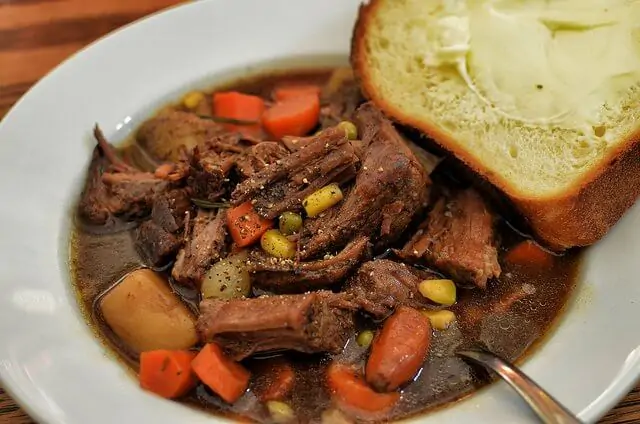
If the thought of canning your own meat makes you cringe, you should reconsider. It’s an efficient way to store food that won’t take up all of your precious freezer space. Although canning meat is admittedly a practice that has fallen off the map for quite some time, utilizing a pressure canner for canning your own meat at home can be both cost and space efficient.
Here is my favorite starter setup from Presto (Amazon) and a more heavy-duty cooker from All-American (Amazon).
Canning meat shouldn’t have to be a scary process. I think many people are fearful to pressure can their own meat because they fear they’ll do something wrong and end up with spoiled meat. Thankfully, with the proper precautions and a quality pressure canner, you’ll be able to can your own meat with ease.
Why should I can my own meat?
If you’ve ever tried to buy food in bulk but realized you don’t have nearly enough freezer space, you’ll find that canning your own meat can be great for storage. There’s no need for freezing or refrigeration. Canning can also be great for when you want to give away food as gifts during the holidays.
What do I have to know about canning meat at home?
For starters, you should be aware that most meats have very low acidity, and that acid is known to inhibit bacterial growth. For this reason, it’s important to be especially careful when canning your own meat with a pressure canner.
When you’re canning foods with higher levels of acidity, utilizing the usual boiling water baths for canning is sufficient and results in quality canned goods. Meat is more prone to spoilage, as the boiling point of water (212°F) is not hot enough to destroy bacteria. Using a pressure canner is the only way to ensure you can heat the water to 240°F to kill off any potentially hazardous microbes.
It’s also worth mentioning that you should keep all of your canning equipment—and any utensils (such as knives and cutting boards) you’ll be using to handle the meat—incredibly clean. This will prevent the incubation and spread of bacterial growth.
Additionally, be sure to only use jars especially intended for canning, not a newly finished glass jar of peanut butter. Canning jars are crafted to resist cracks where bacteria could hide. The lids used in canning jars are also designed to properly seal once they’ve been pressure canned.
Canning your own meat? Stuff your own sausage too.
How do I prepare meat for canning?
Now that we’ve talked through the logistics of food safety, let’s get to the fun parts of canning. When you’re preparing your meat to be canned, most guidelines will call for the meat to be browned and cooked about ⅔ of the way through. This allows the meat to retain some of its original texture and leaves time for the meat to be cooked once again after it’s ready to be removed from the jar. This is not always necessary, and it is possible to can raw meats.
Make sure to only use lean meat for canning. Fat will not can as well as lean pieces of meat, which may affect the overall canning process. Preparing a broth will also be helpful for canning your meat, as it is not unlike a canned soup you buy from the grocery store. I don’t know about you, but I wouldn’t want my soup or meat just sitting in a can of plain water!

What should I be looking for in a pressure canner?
When you’re gearing up to can your own meat at home, be sure to equip yourself with a canner that will be able to handle the size of the jobs you need it to do. If you don’t anticipate canning a large quantity of meat, perhaps you don’t need to invest in a 23-quart pressure canner.
Regardless of the size you choose for your pressure canner, check to see whether your new appliance has a functional pressure gauge. Canned meat needs to be pressurized to a different setting than fruits or vegetables, and an easily readable gauge will help you monitor the pressure inside the machine.
Whether you opt for half-pint, pint, or quart-sized jars in which to can your meat, you’ll want a model that includes a canning rack (also known as a cooking rack) so that you can easily remove the jars from the water. The rack also prevents the glass jars from coming into direct contact with the hot surface that’s sitting over a range top.
Any good pressure canner will also come with a function that does not allow the lid to be opened until a sufficient amount of pressure has been released. This can be especially helpful to prevent any pressure canning-related injuries.
How do I can a specific type of meat?
A recipe book or canning guide will give you the proper time and pressure necessary to safely prepare specific types of meat. By following the manufacturer’s instructions included with your pressure canner, you can be on your way to having a stockpile of canned meats at your disposal whenever you may need them.
For more reviews of pressure canners, check out my post on an excellent pressure canner for beginners, and pressure canners for home canning.
Looking for more ways to store meat long-term? Dehydrators to make beef jerky are an excellent investment. I found the best dehydrator.
Sources
Image credit via Flickr Creative Commons: B.D.’s world and Jeffrey W.





Bryce is not a real professor, but he's real nerdy in the kitchen. He's been barbecuing, chopping, and generally blazing food for many decades. He thinks there's definitely a better spatula or utensil out there that hasn't been invented yet.